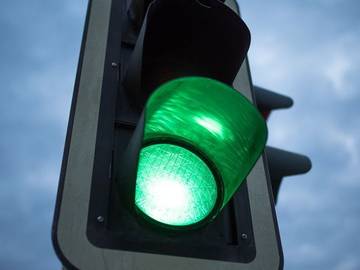Wait—you're not driving as you read this, are you? You're safely somewhere other than behind the wheel of a moving automobile? Oh good. But now we want you to think back to something you regularly encounter in that other situation: the green light.

Since the 1950s, 'lighted' has lost ground to 'lit' as the past tense of 'light.'
Far less annoying than its seemingly-ubiquitous red-hued sibling, the green light is of course the signal on a traffic light that tells drivers to go. Figuratively, green light refers to authority or permission to proceed. It's also used as a verb. To green-light something, such as a project, is to give it authority or permission to proceed—to give it a figurative green light.
The verb green-light is commonly used especially in the business world and in the business-of-entertainment world. It's not new: our current evidence dates it as far back as 1941. (The noun is only slightly older, with current evidence dating it to 1937.)
But when the verb is used, it's not necessarily clear what to do when it comes to that pesky past tense:
The second season of Big Little Lies was officially green-lighted with a seven-episode order last year, with stars and executive producers Nicole Kidman and Reese Witherspoon both returning.
— Emma Dibdin, Elle, 24 Jan. 2018In the interview, after years of gently poking fun at Portland, Oregon’s chill-but-not vibe, Portandia is on its final season. Series co-star Carrie Brownstein unpacks the show’s humor and tells us how a wedding toast kind of doubled as an audition to get the show greenlit.
— Mike Pesca, Slate, 26 Jan. 2018
There we have it: two examples, each showing a different competing form, green-lighted and greenlit.
Those are in truth only the two most common of four competing forms. Greenlighted and green-lit are also in use.
For most of the history of this verb, green-lighted was the most favored option, as a number of corpora that include citations from the past century demonstrate:
More and more commonly, screenwriters who labor to get a movie green-lighted merely stand at the head of a conveyor belt designed by producers and studios to precision-tool hits, sending their scripts along for subsequent handling by a small army of additional writers….
— Jaime Wolf, The New York Times Magazine, 23 Aug. 1998
But when we look at corpora whose evidence all dates to this century we see a different form clearly dominating:
In the United States, the FDA has greenlit a third round of clinical trials, which could be launched in the spring and continue into 2021.
— Lauren Gill, Newsweek, 21 Jan. 2018With many of the new shows being greenlit by Netflix, Amazon and the higher-end cable networks offering fewer episodes a season than a typical broadcast network show, the need to embark on a job search more often has intensified.
— Alex Suskind, The New York Times, 18 Aug. 2017
That's right: green-lighted is swiftly losing ground to greenlit, its sleek hyphenless cousin.
This should not really surprise anyone when we consider the fate of the word's second element. When was the last time you lighted a candle or a match? Green-light the verb is simply following in the well-worn footsteps of light the verb.
The past tense of light was traditionally lighted: in this company's 1864 Webster's Unabridged, both verb entries (one as in "lighting a match" and the other as in "a bird lighting upon the lawn") are accompanied by a note advising readers of lighted as the past tense form but informing them that "sometimes less properly lit" is used.
But as Google's ngrams tell the story, lit overtook lighted as the preferred past tense form of light in books published in the U.S. in the 1950s, and has in the half-century since been the decided favorite. (The same divergence occurred in British English decades earlier, in the 1910s.)
It looks, then, like green-light is just a bit behind the times. Greenlit is simply following an established pattern.
If you really prefer it, you can certainly use green-lighted (or greenlighted or green-lit) as past tense forms of green-light. They are in fact still in use. But the dominance of greenlit is likely to continue to grow. Most writers and editors have already given it the go-ahead.




